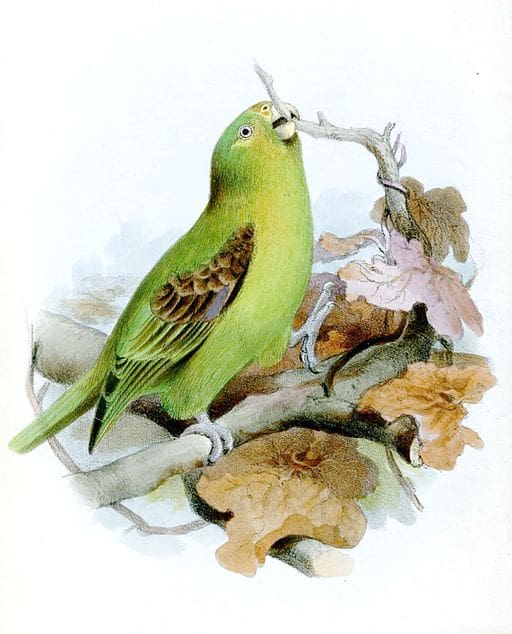Spot-winged Parrotlet
Also known as:
Brown-shouldered Parrotlet
Also known as:
Brown-shouldered Parrotlet

Touit

stictopterus
Size:
17 cm (6.6 in)
Weight:
71-84 g (2.5-3 oz)
Subspecies including nominate:
one
Colour Adult:
Male-green/yellow in general; area around lores and eyes green/yellow; black/brown bend of wing; brown scapulars, lesser wing coverts and inner median wing coverts with white spotting; dull orange on outer two median wing coverts; dark brown secondaries and secondary coverts; green underwing coverts; uppertail green with red /brown margins on inner webs of lateral feathers; undertail olive/yellow. Beak olive/yellow with grey at base. Eye yellow/brown. Female-green upperwing coverts with exposed black bases to feathers; brighter yellow lores and forecheeks; brown primary coverts widely edged with green.
Colour Juvenile:
As in adult female.
Call:
Calls made in flight are harsh and high-pitched, or raspy.
More Information:
Content Sources:
CITES
BirdLife International
Cornell Lab of Ornithology/Birds of the World
Parrots: A Guide to Parrots of the World, Juniper and Parr, 1998
Parrots of the World, Forshaw, 2006. 2010 edition
Lexicon of Parrots, Thomas Arndt.
Captive Status:
Not usually seen in captivity.
Longevity:
—
Housing:
House in tall enclosure with many plantings for hiding, minimum temperature 20 C (68 F).
Diet:
Fruits such as: apple, pear, banana, orange, cactus fruits, mangos, papaya; berries such as: pyracantha, mountain ash, elder; lory nectar; vegetables such as: carrots, celery, green beans and peas in the pod; green leaves such as: Swiss chard, lettuce, kale, dandelion, chickweed; half-ripened seeds; sprouted millet, canary grass seed, oats, barley and a little sunflower; vitamin and mineral supplements; complete kibble for small parrots if taken.
Enrichment:
—
Nest Box Size:
—
Clutch Size:
Not recorded.
Fledging Age:
—
Hatch Weight:
—
Peak Weight:
—
Weaning Weight:
—
World Population:
5,000-21,000 mature individuals, decreasing.
IUCN Red List Status:
Near Threatened
CITES Listing:
Appendix II
Threat Summary:
Considered uncommon, although likely partly unrecorded due to its shy nature. This species is rare and declining due to continuing deforestation and fragmentation for illegal crops and human settlement, particularly in Colombia. Exploration of suitable habitat in E Ecuador and NE Peru needed to clarify status. Across its entire range, tree cover loss is 1.5% over the last three generations (10.8 years). However, rates of habitat loss may be higher locally in Colombia, amounting to up to 10% over three generations or potentially even higher. To account for locally higher rates of habitat loss and additional impacts of forest degradation, the overall rate of population decline is tentatively 1-19% over three generations.
Range:
C Colombia, on western slopes of Cordillera Central in Cauca, western slopes of Cordillera Oriental in Cundinamarca, Sierra de la Macarena in Meta and possibly E Narino and eastern slopes of Andes in E Ecuador to N Peru.
Habitat:
Found from 350-2300 m (1148-7544 ft) in tall humid subtropical forest; also reports from savanna-like woodland and stunted ridge-top growth.
Wild Diet:
Feeds on fruit and seeds, including mistletoe; may feed on maize crops and sometimes in Ficus and Clusia trees. Recorded feeding on termites in Colombia.
Ecology and Behaviour:
Little known; it is thought that this species moves in response to food availability. Usually seen in groups of up to 10 individuals, with larger flocks where food abundant. Is quiet and easily overlooked while resting or feeding in dense foliage.
Clutch and Egg Size:
Not recorded.
Breeding Season:
Possibly March, Ecuador.
Related Links:

![© Joseph Wolf [Public Domain] via Wikimedia Commons An illustration depicts a Spot-winged Parrotlet](https://parrots.org/wp-content/uploads/2023/01/wpt_Spot-winged-Parrotlet_1388-100x100.jpg)